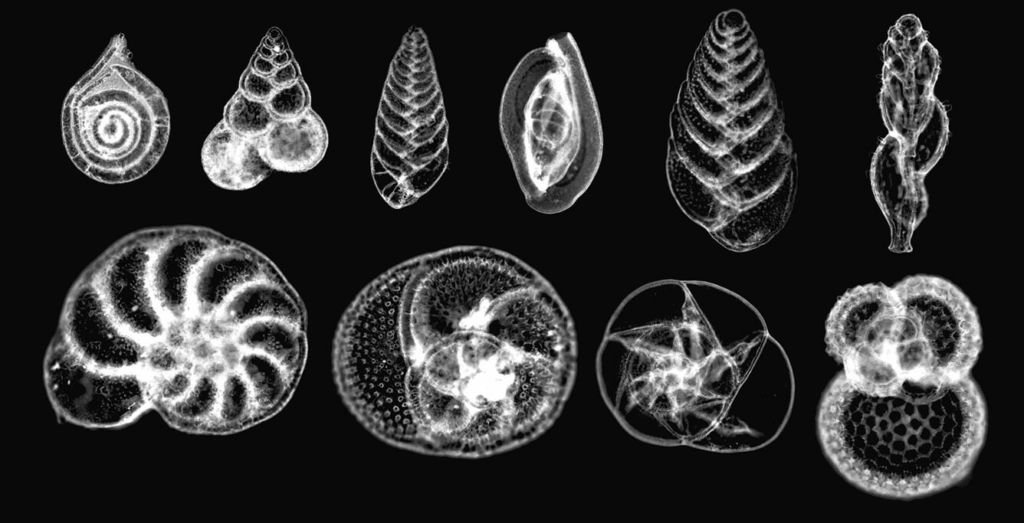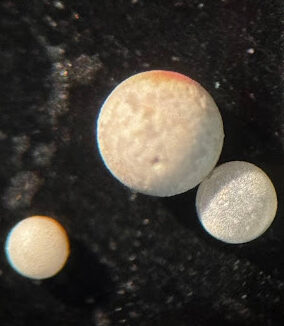When people think about the ocean, they usually picture some marine life such as whales, dolphins, sharks and coral reefs, but some of the most important creatures that play a big role in our oceans are things we can’t see with just the naked eye. These tiny architects of marine ecosystems called Foraminifera are single celled organisms that drive chemical cycles that sustain life all across the sea, there are around 50,000 different foram species all ranging in different shapes, sizes, and shell structures, each uniquely adapted to their environment, as shown in the image below illustrating a variety of foram species [Fig 1]. One of the most important chemical cycles the ocean has to offer is the nitrogen cycle, which fuels the oceans largest and smallest creatures; from primary productivity to large scale marine mammals. This cycle also influences climate on a global scale and at the center of it all are microbes and foraminifera – microscopic and single celled, yet mighty players in controlling ocean chemistry, and even global climate.

[Fig 1. Photomicrograph of calcium carbonate shells from ten species of Foraminifera, taken by Randolph Femmer at USGS – December 31, 2004. More info at; https://www.usgs.gov/media/images/foraminiferans-10-species-3.]
You might ask, “Why should we care about nitrogen?” Nitrogen is a huge deal in the marine ecosystem, phytoplankton that absorb and assimilate dissolved inorganic nitrogen (like nitrate NO₃⁻ and ammonium NH₄⁺) for photosynthesis, form the base of the marine ecosystem. Nitrogen is essential for marine productivity and must be in a ‘Goldilocks zone’ to stay useful to marine ecosystems. Too little amounts of nitrogen can limit microbial growth; too much (especially near coasts) can trigger harmful algal blooms and oxygen depleted zones.
You may be wondering how Foraminifera play into this. Foraminifera (or for short, Forams) are single celled organisms that build calcium carbonate shells and are best known (and used, in most purposes) for their fossil record. When forams die and fall to the seafloor they become part of the sediment- scientists study these sediment cores full of forams to reconstruct past climates. But in the present, forams are more than just fossil recorders. Some species of forams host nitrogen fixing bacteria, which can convert nitrogen gas (N₂) from the water into nitrogen usable by other organisms, like nitrate (NO₃⁻) and ammonium (NH₄⁺). With this they help increase nitrogen availability while also supporting the growth of plankton and other marine organisms.
The influence of foraminifera extends even further- past marine nitrogen availability affects phytoplankton growth, which plays a crucial role in the biological carbon pump. Phytoplankton use nitrogen to grow, and as they photosynthesize they absorb carbon dioxide from the atmosphere, so when plankton die or are consumed, some of that carbon which they contain, sinks to the deep ocean (a carbon sink). This process removes CO₂ from the atmosphere for decades to centuries, helping to regulate Earth’s climate. Phytoplankton are not the only organisms that can leave behind traces of the nitrogen cycle, forams do something similar as well; their calcium carbonate shells hold nitrogen isotopes which scientists can analyze in sediment cores to reconstruct how nitrogen levels (and by using this, marine productivity) have changed over thousands to millions of years. This microfossil record helps researchers learn about past climate events such as glacial and interglacial periods.

[Fig 2. Taken by Hunter Strong 7/9/2025 at University of Rhode Island – Bay Campus in the GSO lab. Imaged is the Foraminiferan; Orbulina universa. This foram in specific was in a sediment core taken from the Mozambique Channel (site U1474D) in 2016 by a research expedition (Exp.361)] – Cruise Info: https://iodp.tamu.edu/scienceops/expeditions/southern_african_climates.html